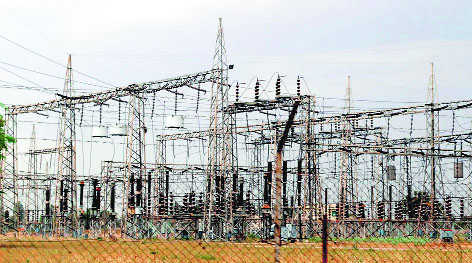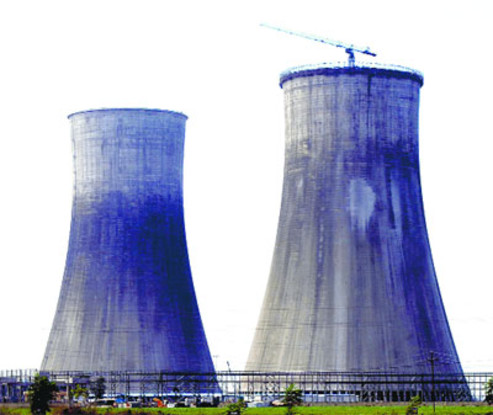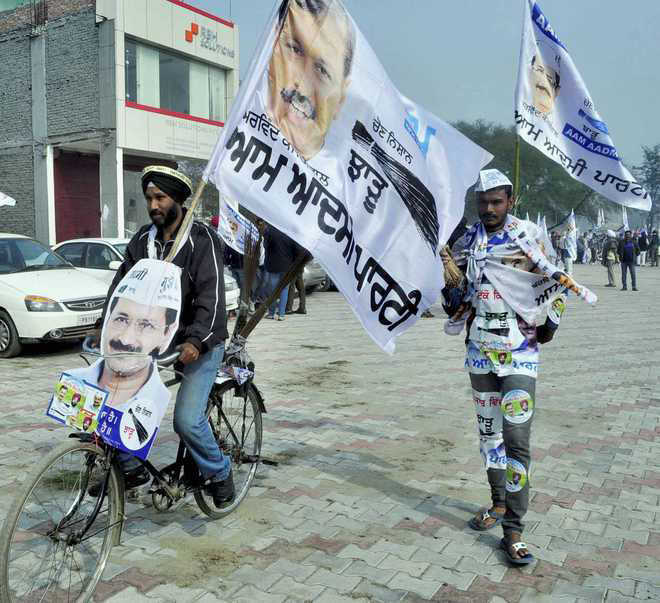How Punjab can pack in a power punch
Bhupinder Singh
The government should immediately initiate a process for acquiring a thermal plant of super-critical technology by infusing equity. Money can be arranged by disposing of unviable generation assets. A revamp will bring long-term benefits to the state.

CUTTING COST: An effort should be made to reduce generation cost and set up thermal plants with the latest technology. A view of the electricity high power tower in a grid on Bhadson Road in Patiala. Tribune Photo: Rajesh Sachar.

THE supply of electricity at affordable rates has assumed utmost importance for the government as well as consumers The average rate of electricity in Punjab, with the projected expenditure of Rs 3,2718 crore for the year 2017-18, shall be Rs 6.82 per unit. This comprises of Rs 3.74 towards power purchase, Rs1.11 towards employee expenses, 38 paise as fuel charges, 77 paise as interest burden, 25 paise as transmission charges, and 57 paise towards operations and maintenance charges, return on equity and depreciation cost. After adding government levies, the rate shall be around Rs 8 per unit.Therefore, the reduction of tariff so as to attract industrial investment in the state is a challenging task.
Comparison of rates
Last year, the per unit rate charged from the consumers is Rs 5.65 in UP, Rs 7.52 in Haryana, Rs 6.83 in Rajasthan, Rs 7.31 in Delhi and Rs 5.79 in Punjab. However, Punjab collects nearly Rs1.15 for each unit of electricity as the government levies against only 15 paise per unit in Haryana, 8 paise per unit in U.P and 60 paise per unit in Rajasthan. The final average cost of electricity to the consumers which is sum of government levies and tariff cost is around Rs 6.94 per unit in Punjab compared to Rs 7.67 for Haryana, Rs 5.73 for UP, Rs 7.49 for Rajasthan and Rs 7.68 for Delhi.The Centre has launched Ujjawal DISCOM Assurance Yojna scheme to enable state goverments to take over the outstanding debt of the distribution companies which stands at Rs 26,000 crore for Haryana, Rs 39,908 crore for UP, Rs 60,397 crore for Rajasthan and Rs 15,628 crore for Punjab — as on September 30, 2015. Haryana, U.P and Rajasthan have committed to take over debt in first three years of operation of the scheme. On the contrary, Punjab shall takeover debt only in the fifth year of the operation of the scheme, that is in 2020-21.The scheme also mandates tariff hike of 5 per cent in 2016-17 and 9 per cent in 2017-18 to ensure financial sustainability of PSPCL. Contrary to this, tariff in Punjab was reduced by (-) 0.65 per cent last year.
Technical & commercial losses
Punjab is the only state in North India which has been able to control the theft of power and has achieved reduction of aggregate technical and commercial losses below 15 per cent. The pillar-box scheme, initiated by PSPCL engineers, worked as a game changer in bringing down the aggregate technical and commercial losses from around 22 per cent in 2010 to 14.63 per cent in 2016.However, there are many divisions where these losses are still high such as Bhikhiwind (40.54 per cent), Patti (35.10 per cent), Malout (37.90 per cent), Badal (29.67 per cent), Jalalabad (28.12 per cent), Amritsar (28.17 per cent) and Abohar (28 per cent). Punjab can achieve further reduction of losses by 3-4 per cent if pillar boxes are installed in these areas. This is possible only with strong government support.In comparison, the aggregate technical and commercial losses of Haryana are 28.05 per cent, Rajasthan 25 per cent and UP 32.36 per cent which indicate higher power theft levels in these states. Interestingly, the south distribution company of Gujarat with a similar agricultural base as Punjab has losses of more than 25 per cent. Punjab shall be paying the subsidy bill of Rs 8,000 crore this year. This includes Rs 5,807 crore for agricultural power (AP). Last year, Haryana paid Rs 6,434 crore as AP subsidy for supplying 9,094 MUs of agriculture power at the rate of Rs 6.64 per unit. In contrast, Punjab paid Rs 5,187 crore for supplying 1,1327 MUs of agricultural power at the rate of Rs 4.58 per unit. If Punjab pays subsidy on the Haryana pattern, then the tariff rate of other consumers can be reduced by 37 p/unit.Punjab has three thermal plants under the state sector — 460 MW at Guru Nanak Dev Thermal Plant (GNDTP), Bathinda, 1260 MW at Guru Gobind Singh Super Thermal Plant (GGSSTP), Ropar and 920 MW at Guru Hargobind Thermal Plant (GHTP,), Lehra Mohabbat and three thermal plants — 1400 MW at Rajpura, 1980 MW at Talwandi Sabo and 540 MW at Goindwal Sahib — have been added in the private sector. The share of state thermal plants in the energy availability has gone down from 38 per cent to 8 per cent in the last five years and share of hydel power hasreduced from 19 per cent to 12 per cent.New private sector plants built on super-critical technology are more efficient than the ageing state plants. The generation cost is lower in the case of these plants. However, it has resulted in non-utilisation of cheap and good quality coal available from the state-owned Pachhwara coal mine. If this is used, it can reduce generation cost by around 30 p/unit. The primary reason for this has been that Punjab does not own a thermal plant operating on super-critical technology. Surplus power and fixed chargesPower utilities arrange power from various sources to supply uninterrupted power to the consumers. The power is then supplied as per the demand of the system which has seasonal and daily variations. This results in the payment of some amount of fixed charges even for unutilised power to the central sector plants, state plants and private sector plants. Punjab has 25000 MU i.e. 30 per cent surplus power and even Delhi with 9745 MU has 30 per cent surplus power. The consumers have to bear fixed charges to avoid power cuts.There are no power cuts in Punjab even for the rural consumers and no regulatory measures for the industry.The government can ensure financial sustainability of the power companies as well as reduce the electricity tariff by 40 p/unit if it takes over debt as per UDAY scheme, by Re1/unit by rationalising govt levies and by 25 p/unit by installing pillar boxes in high theft areas. In this way, tariff can be reduced immediately by Rs 1.65 per unit. The government should immediately initiate process for acquiring a thermal plant of super-critical technology by infusing equity which can be arranged by disposing off unviable generation assets. Besides huge tangible and intangible long-term benefits to the state, it shall reduce generation cost by 65p/unit by saving of fixed and variable charges. Electricity is the driving force for all other sectors of economy. Its cost reduction can reap in huge dividends elsewhere. The writer is President, Punjab Power Engineers Association
AAP’s Punjab predicament
Need to carve out a distinctive personality

FOR a party predicated on a limited but please-all agenda of cracking down on corruption and drugs, AAP’s denouement in Punjab was not hard to predict once it fell well short of the half-way mark in the assembly polls. After its near-total eclipse in the Delhi municipal corporation polls, it was natural for its Punjab leaders to snipe at each other in the scramble to bag the limited number of posts up for grabs or desert the party for better vistas. There are also indications that many state-level leaders who still remain, either because they are legislators or they have burnt their bridges with alternative political choices, are chafing with AAP’s Delhi durbar continuing to hold the reins.The churning within AAP in Punjab is not unique to it. Many political parties have experienced a loss of faith following a debilitating electoral loss. The departure of leaders like Gurpreet Ghuggi is to be expected where the spoils of office aren’t forthcoming. India’s first-past-the-post electoral system hardly gives any solace to the runner-up but AAP remains a beacon of hope in the believers of alternative politics. Its internal squabbles, too many to recount, have prevented it from reshaping itself as the principal opposition party in the state. One reason is that AAP leaders are largely reposing their faith in social media to send their messages across.The need of the hour for AAP is to put the electoral loss behind it. When it comes to introspection, AAP’s cause will be better served if it carves out a more consensual mechanism for stock-taking and charting out the future course of action. This was supposed to be a party which listened to the people. Given that Punjab’s society is multi-layered, AAP has to build a collegiate approach and pick and choose its target electorate and issues. The Punjab Government is currently riding its honeymoon phase. Space will soon open up for an issue-based Opposition. AAP should ready itself for that eventuality. The desertions will affect the top deck and the quarter of the electorate that opted for its candidates should not be let down.
Soon, Rs7-cr subsidy for border belt
Tribune News Service
Chandigarh, May 11
Chief Minister Captain Amarinder Singh today directed his Principal Secretary to expedite the release of pending subsidy to the tune of Rs 7 crore for the development of industry in the border areas of Tarn Taran and Amritsar.The directive followed a request for the release of the subsidy by a delegation of the PHD Chamber of Commerce and Industry (PHDCCI), which called on him to discuss steps to revive the state’s ailing industry.The Chief Minister assured the delegation of full infrastructural support by his government along with uninterrupted power at affordable rates for the industry.Amarinder said he had personally received stupendous response from the country’s top industry leaders during his visit to Mumbai to promote Punjab as an attractive investment destination recently.Observing that the state has surplus power, the CM said his government was studying options to sell surplus power to neighbouring countr
ies such as Pakistan and Nepal, and he had urged the PM to formulate a policy for the same.He informed the delegation that the Ambanis were ready to supply power to the state at Rs 5 per unit, which was much cheaper than the actual cost of generation in the state.
HC: Behoves a minister?
Rejects AG’s plea against PIL on Sidhu in ‘spicy comedy’

Navjot Singh Sidhu
Sanjeev Singh Bariana
Tribune News Service
Chandigarh, May 11
The Punjab and Haryana High Court today did not accept the plea of the Punjab Advocate General who questioned the “maintainability” of a public interest litigation (PIL) against propriety of Cabinet Minister Navjot Singh Sidhu appearing in a popular “spicy comedy” television series, “The Kapil Sharma Show”.“Lakhs follow the example set by ministers, and their public conduct is watched. In such a situation, can a minister resort to a conduct that is not in consonance with dignity and status of a Cabinet Minister?” a Division Bench of Justices SS Saron and Darshan Singh asked the AG.(Follow The Tribune on Facebook; and Twitter @thetribunechd)The observation came in response to a PIL by advocate HC Sharma, asking the Punjab Government “if it was appropriate for Tourism, Cultural Affairs and Local Bodies Minister Navjot Singh Sidhu to appear in a TV show?”The court heard arguments for two hours before adjourning proceedings till August 2.AG Atul Nanda said the PIL was not maintainable under the 2010 HC guidelines. The AG said the code of conduct for ministers was not enforceable through courts.Unimpressed, the Bench observed that an issue of public importance had been raised.Petitioner Sharma said Sidhu was not only participating in “Kapil Sharma Show” but also appearing in an advertisement promoting a “magic machine” for learning spoken English. He quoted the 2004 judgment of the Supreme Court in Jayalalithaa’s case, wherein referring to enforceability of the code of conduct, the SC had observed that “morally speaking, can there be one law for small officials and another law for the CM?Is the code of conduct meant only to be kept as an ornamental relic in a museum, but not to be practised?”

